TOEFL Junior 小托福阅读课件
- 格式:ppt
- 大小:2.49 MB
- 文档页数:56
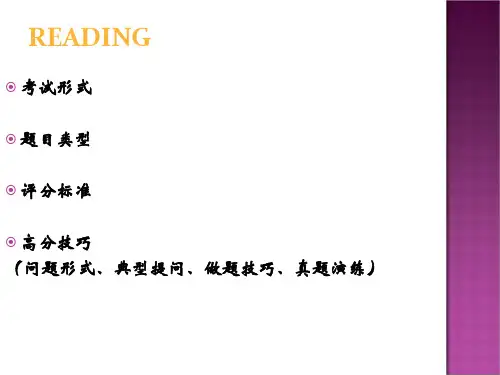
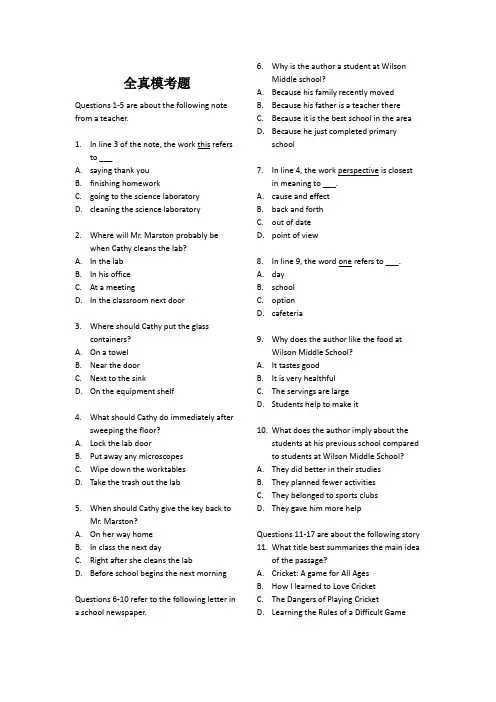
全真模考题Questions 1-5 are about the following note from a teacher.1.In line 3 of the note, the work this refersto ___A.saying thank youB.finishing homeworkC.going to the science laboratoryD.cleaning the science laboratory2.Where will Mr. Marston probably bewhen Cathy cleans the lab?A.In the labB.In his officeC.At a meetingD.In the classroom next door3.Where should Cathy put the glasscontainers?A.On a towelB.Near the doorC.Next to the sinkD.On the equipment shelf4.What should Cathy do immediately aftersweeping the floor?A.Lock the lab doorB.Put away any microscopesC.Wipe down the worktablesD.Take the trash out the lab5.When should Cathy give the key back toMr. Marston?A.On her way homeB.In class the next dayC.Right after she cleans the labD.Before school begins the next morningQuestions 6-10 refer to the following letter in a school newspaper. 6.Why is the author a student at WilsonMiddle school?A.Because his family recently movedB.Because his father is a teacher thereC.Because it is the best school in the areaD.Because he just completed primaryschool7.In line 4, the work perspective is closestin meaning to ___.A.cause and effectB.back and forthC.out of dateD.point of view8.In line 9, the word one refers to ___.A.dayB.schoolC.optionD.cafeteria9.Why does the author like the food atWilson Middle School?A.It tastes goodB.It is very healthfulC.The servings are largeD.Students help to make it10.What does the author imply about thestudents at his previous school compared to students at Wilson Middle School?A.They did better in their studiesB.They planned fewer activitiesC.They belonged to sports clubsD.They gave him more helpQuestions 11-17 are about the following story 11.What title best summarizes the main ideaof the passage?A.Cricket: A game for All AgesB.How I learned to Love CricketC.The Dangers of Playing CricketD.Learning the Rules of a Difficult Game12.In line 1, the word detested is closest inmeaning to ___A.hatedB.playedC.wantedD.watched13.What best describes the author’s attitudetoward cricket when he was very young?A.it was boring to watchB.it was difficult to learnC.it was fun to talk aboutD.it was dangerous to play14.According to the author, what wassurprising about some of the cricketgames he played?A.They were played without batsB.They were played on rooftopsC.No one cared who won themD.No one got hurt playing them15.The author describes memories of all ofthe following EXCEPT ___.A.how the sun felt on his skinB.how the ball sounded hitting the batC.how the sky turned from light to darkD.how the rules of the game causedarguments16.What change does the author describe?A.He could not remember of the rules ofcricket at first, but then he decided it didnot matter.B.He was afraid of getting hurt playingcricket at first, but then he stopped being afraidC.He did not like cricket at first, but then hebegan to enjoy itD.He liked playing cricket at first, but thenhe grew tired of it17.In line 13, the word fond is closest inmeaning to ___.A.oldB.cruelC.happyD.interestingQuestions 18-23 are about the following story.18.Why did Edward go to the Millers’ house?A.borrow a flashlightB.To take care of LucasC.To welcome the Millers to theneighborhoodD.To help the Millers move into their house19.In line 7, the word entertain is closest inmeaning to ___.A.look forB.cook forC.play withD.argue with20.What did Edward and Lucas do beforeLucas went to bed?A.They built a tower of blocksB.They looked for a flashlightC.They put books on a shelfD.They drew pictures21.In line 26, the word one refers to a ___A.shelfB.chairC.monsterD.flashlight22.How did Lucas probably feel about goingto bed?A.Disappointed and afraidB.Angry and nervousC.Relieved and tiredD.Sad and confused23.Why did Lucas keep calling out toEdward?A.He saw something under the bedB.He did not want to be left aloneC.He could not reach the book on the shelfD.He forgot where the wooden blocks were.Questions 24-31 are about the following newspaper article24.What would be the most appropriateheadline for this article?A.Local School Gets GreenerB.Student Wins Science AwardC.Principal Discovers New TreeD.Teacher Leads Ecological Club25.What problem does Principal Webb talkabout?A.Pollution in the cityB.Classrooms that are too hotC.Tall trees that block the viewD.Wild animals that destroy trees26.What did the Ecology Club do for MarinaHills High School?A.It helped design the school yardB.It put flowers in the classroomsC.It sold seeds to the schoolD.It provided free trees27.In line 13, the word seedlings is closest inmeaning to ___.A.bird nestsB.young treesC.packages of seedsD.members of a club28.What decision was changed?A.Which trees should be dug upB.When the old trees should be cut downC.Where the new trees should be plantedD.Which type of trees should be chosen29.In line 22, the word them refers to ___A.treesB.classesC.studentsD.teachers30.What can be inferred from the articleabout eucalyptus and willow trees?A.They grow quicklyB.They become extremely tallC.They are less expensive than fruit treesD.They do not grow flowers in thespringtime31.What does Principal Webb imply aboutthe local birds?A.They make their nests on the groundB.They are not often seen at the schoolC.There are fewer of them due to thepollution problemD.They fly into the classrooms when thewindows are openQuestions 32-42 are about the following passage.32.What is the main topic of the passage?A.Places where flying animals choose tolandB.Why scientists have difficulty observingbatsC.Differences in the eating habits of batsand birdsD.Ways in which bats move differently frombirds33.In line 2, the word terrestrial is closest inmeaning to___.A.high-flyingB.fast-movingC.tree-climbingD.ground-living34.According to the passage, what skill iscrucial for flying animals?A.Diving underwaterB.Slowing down to landC.Flying over great distancesD.Balancing on high branches35.Which of the following is a falseassumption about bats that was recently corrected?A.They cannot hearB.They sleep upside downC.They fly similarly to birdsD.They hide in tree branches36.According to the passage, what is anadvantage that bats have over birds? A.bats can land on a greater variety ofsurfacesB.Bats can turn in the air more quicklyC.Bats can eat while flyingD.Bats are lighter37.In line 11, the work incorporate is closestin meaning to ___.A.addB.deliverC.includeD.discover38.In line 14, the word it refers to ___A.batB.birdC.directionD.maneuverability39.The researchers used all of the followingto study bats EXCEPT ___sB.paintC.cablesD.cameras40.In line 20, the word suspended is closestin meaning to ___.A.hangingB.enteringC.fallingD.living41.In line 24, the word slam is closest inmeaning to ___.A.crashB.bringC.breakD.change42.According to the passage, what helpsdetermine a bat’s landing speed?A.What it eatsB.How old it isC.How big it isD.Where it lives.。
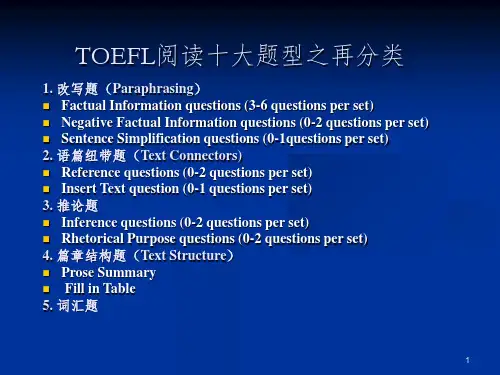

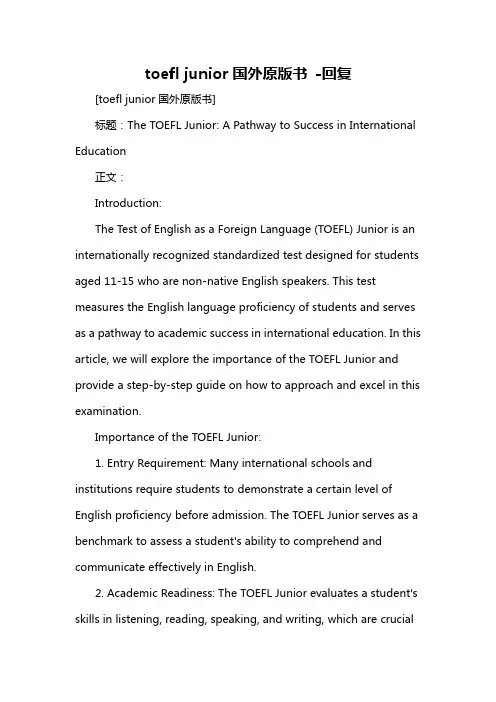
toefl junior国外原版书-回复[toefl junior国外原版书]标题:The TOEFL Junior: A Pathway to Success in International Education正文:Introduction:The Test of English as a Foreign Language (TOEFL) Junior is an internationally recognized standardized test designed for students aged 11-15 who are non-native English speakers. This test measures the English language proficiency of students and serves as a pathway to academic success in international education. In this article, we will explore the importance of the TOEFL Junior and provide a step-by-step guide on how to approach and excel in this examination.Importance of the TOEFL Junior:1. Entry Requirement: Many international schools and institutions require students to demonstrate a certain level of English proficiency before admission. The TOEFL Junior serves as a benchmark to assess a student's ability to comprehend and communicate effectively in English.2. Academic Readiness: The TOEFL Junior evaluates a student's skills in listening, reading, speaking, and writing, which are crucialcomponents of academic success in an English-language classroom. By taking this test, students can identify areas where they need improvement and can work on enhancing their overall language abilities.Step-by-step Guide to Excel in the TOEFL Junior:Step 1: Familiarize yourself with the test format and content.The TOEFL Junior consists of three sections: Listening Comprehension, Language Form and Meaning, and Reading Comprehension. It is essential to understand the structure and requirements of each section before starting your preparation. You can find sample test questions from official TOEFL Junior study materials or websites to gain an understanding of the type of questions you may encounter.Step 2: Develop your English language skills.To excel in the TOEFL Junior, it is crucial to have a strong foundation in English language skills. Practice reading English books, watching English movies, and listening to English podcasts or music to improve your overall language proficiency. Enhance your vocabulary by learning new words daily and utilizing them in your writing and speaking practice. Engaging in conversations with native English speakers or joining language exchange programs can also help in improving your speaking and listening skills.Step 3: Master effective test-taking strategies.Understanding effective test-taking strategies can significantly improve your performance in the TOEFL Junior. For the Listening Comprehension section, develop strong note-taking skills and practice paraphrasing the information you hear. In the Language Form and Meaning section, focus on understanding grammar rules, vocabulary usage, and sentence structure. Practice reading various texts to improve your reading comprehension skills, and pay attention to details and main ideas. Additionally, practice your writing skills by creating outlines, brainstorming ideas, and proofreading your essays.Step 4: Take timed practice tests.Regularly taking timed practice tests is essential to build your test-taking stamina and familiarize yourself with the actual exam environment. Set aside specific study times and simulate a test-like environment where you complete the sections within the given time limits. Review your answers carefully, identify your strengths and weaknesses, and focus on improving your weaker areas with targeted practice.Step 5: Seek guidance and support.Consider enrolling in a TOEFL preparation course or seeking guidance from a qualified instructor or tutor. They can provide youwith valuable tips, resources, and personalized feedback to help you enhance your English language skills and improve your test performance. Additionally, join online forums or study groups to connect with other students preparing for the TOEFL Junior. Learning from their experiences and sharing your own can be beneficial for everyone involved.Conclusion:The TOEFL Junior is a significant stepping stone for students aiming to pursue international education. By understanding the importance of this examination and following a step-by-step guide to prepare effectively, students can increase their chances of success in the TOEFL Junior and lay a strong foundation for academic growth and future opportunities in international education.。
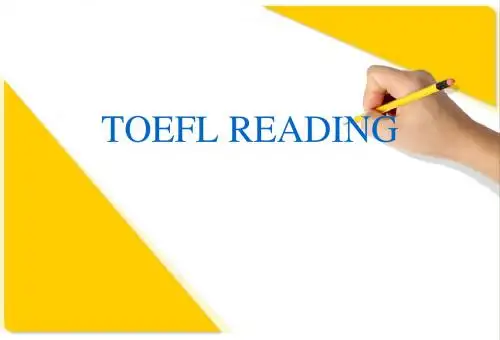
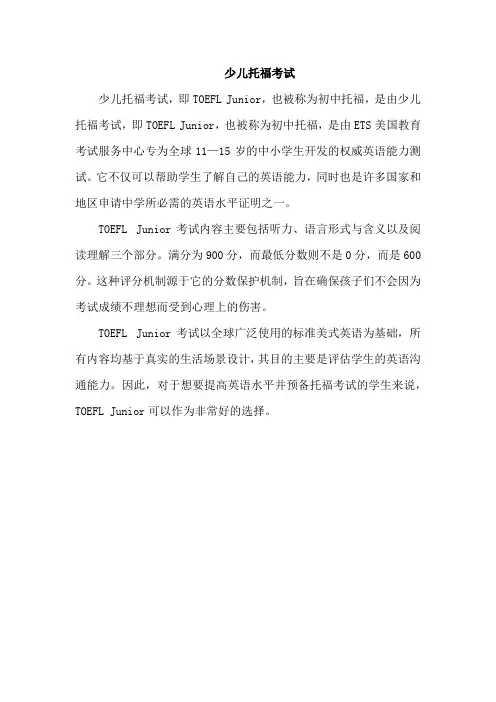
少儿托福考试
少儿托福考试,即TOEFL Junior,也被称为初中托福,是由少儿托福考试,即TOEFL Junior,也被称为初中托福,是由ETS美国教育考试服务中心专为全球11—15岁的中小学生开发的权威英语能力测试。
它不仅可以帮助学生了解自己的英语能力,同时也是许多国家和地区申请中学所必需的英语水平证明之一。
TOEFL Junior考试内容主要包括听力、语言形式与含义以及阅读理解三个部分。
满分为900分,而最低分数则不是0分,而是600分。
这种评分机制源于它的分数保护机制,旨在确保孩子们不会因为考试成绩不理想而受到心理上的伤害。
TOEFL Junior考试以全球广泛使用的标准美式英语为基础,所有内容均基于真实的生活场景设计,其目的主要是评估学生的英语沟通能力。
因此,对于想要提高英语水平并预备托福考试的学生来说,TOEFL Junior可以作为非常好的选择。


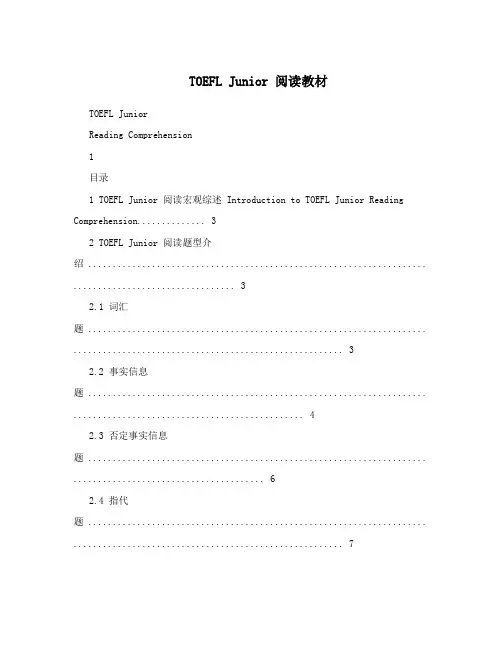
TOEFL Junior 阅读教材TOEFL JuniorReading Comprehension1目录1 TOEFL Junior 阅读宏观综述 Introduction to TOEFL Junior Reading Comprehension (3)2 TOEFL Junior 阅读题型介绍 ..................................................................... (3)2.1 词汇题 ..................................................................... . (3)2.2 事实信息题 ..................................................................... .. (4)2.3 否定事实信息题 ..................................................................... (6)2.4 指代题 ..................................................................... . (7)2.5 修辞目的题 ..................................................................... .. (9)2.6 推断题 ..................................................................... .. (10)2.7 主旨题 ..................................................................... ..................................................... 11 3 TOEFL Junior 阅读篇章练习 ..................................................................... . (12)天文类 ..................................................................... (12)地理地质类 ..................................................................... . (20)生物类 ..................................................................... (29)生态学类 ..................................................................... .. (36)古生物类 ..................................................................... .. (42)人文社会科学类 ..................................................................... .. (49)美国历史题材 ..................................................................... (54)文学艺术类 ..................................................................... . (77)21 TOEFL Junior 阅读宏观综述 Introduction to TOEFL Junior Reading ComprehensionTOEFL Junior阅读考试主要考查学生寻找文章基本信息,进行合理推理以及理解文章内容概要的能力。
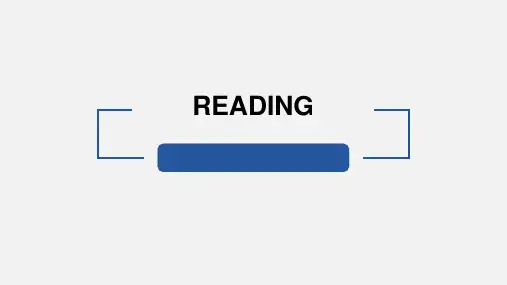
toefl junior 阅读
想要提高托福 Junior 阅读水平,可以参考以下方法:
- 积累词汇:通过眼看、耳听、口说、手写等多种方式结合语境来记忆词汇。
- 精读练习:在刚开始接触阅读部分时,可以先注重每篇文章的阅读质量,除了做题以外,还要花时间做通篇的复盘精读,弄懂文中每个单词和短语的含义,准确理解每个句子的意思以及梳理文章展开的方式。
- 泛读补充:除了做TOEFL Junior 的练习题以外,学生在备考时也可以选择其他阅读材料进行泛读。
托福 Junior 阅读部分难度跨度较大,建议通过多加练习来提高阅读能力。